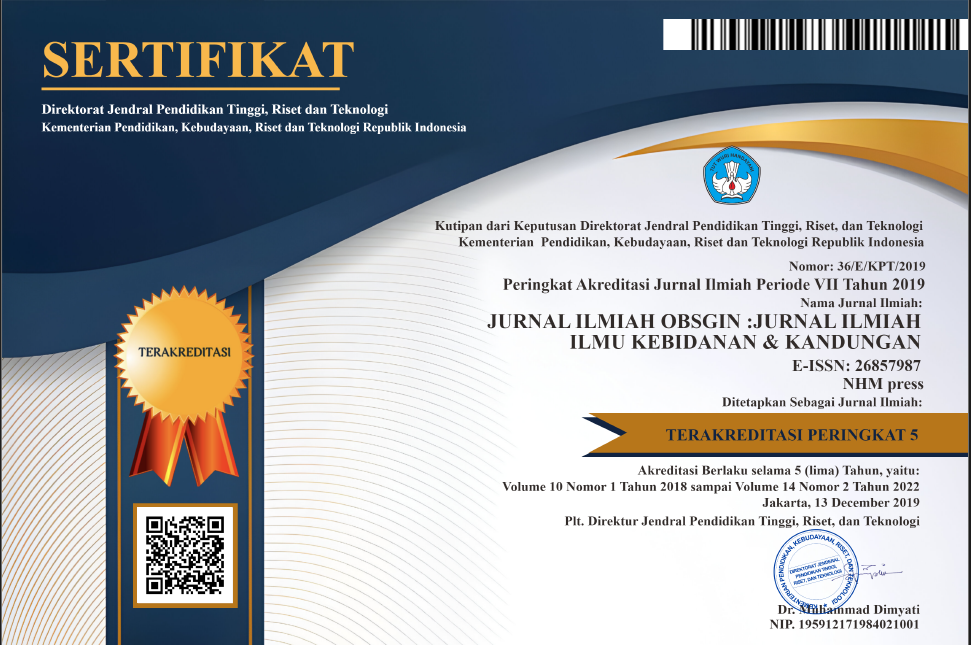HUBUNGAN NILAI STATUS GIZI DENGAN NYERI DISMENORE PRIMER PADA REMAJA PUTRI SMA NEGERI 1 PASIRIAN LUMAJANG
Abstract
Primary dysmenorrhea is spasmodic and limited pain felt in the lower abdomen and can radiate to the back and inner thighs such as squeezing, throbbing headache, nausea, vomiting, lower back pain and even fainting. Factors that can trigger and exacerbate primary dysmenorrhea are family history of dysmenorrhea, history of exercise habits and nutritional status (BMI) in the underweight and overweight categories which have an impact on reproductive function in adolescents. The purpose of this study was to analyze the correlation between nutritional status and primary dysmenorrhea pain in class X students at SMA Negeri 01 Pasirian Lumajang. The research design used descriptive quantitative research with a cross-sectional approach. The population in this study were all 210 class X students with a total sample of 60 students using the simple random sampling method by collecting data, namely anthropometric measurements. The research test used Spearmen's Rank to determine whether there was a correlation between the value of nutritional status and primary dysmenorrhea. The Rho value with the help of the SPSS 26 analysis software analysis with Spearmen Rank shows the results Sig(2-tailed) = 0.039 so that which means that the Sig(2-tailed) value is less than vulnerable 0.05 or 0.01, then the relationship is said to be significant. The correlation coefficient is 0.765, the correlation strength value is 0.76-0.99, and the correlation is very strong because the correlation value is close to -1 or + 1, the correlation is getting stronger, which means that H0 is rejected or H1 is accepted. It can be interpreted that there is a relationship between the value of nutritional status and primary dysmenorrhea pain at SMA Negeri 01 Pasirian Lumajang.
References
Alizadeh CS, Mohammad, dkk. 2017. Calcium with and without magnesium for primary dysmenorrhea: a double-blind randomized placebo-controlled trial. International Journal of
Almatsier, S unita.2009. Prinsip Dasar Ilmu Gizi. Jakarta : Gramedia Pustaka Utama.
Anwar, M., Ali, B., & Prabowo, P. 2014, Ilmu Kandungan edisi Ketiga. Jakarta: PT Bina Pustaka Sarwono Prawirohardjo.
Badan Pengawas Obat dan Makanan Republik Indonesia tahun. 2013. Informasi Kandungan Zat Gizi Pangan Jajanan Anak Sekolah oleh Direktorat Standarisasi Produkpangan Deputi Bidang Pengawasan Keamanan Pangandan Bahan Berbahaya. https://standarpangan.pom.go.id/dokumen/pedoman/Buku_Informasi_Kandungan_Gizi_PJAS.pdf (diakses pada 29 Desember 2020)
Bakta, I. M. 2006. Hematologi Klinik Ringkas. Jakarta: EGC.
Beckmann, C.R.B. et al., 2014. Obstetric and Gynecology 7th ed., Philadelphia: Lippincott Williams & Wilkins Collaboration with the American College of Obstetricians and Gynecologists.
Dewantari, N. M. 2013. Peranan Gizi Dalam Kesehatan Reproduksi. Jurnal Skala Husada.
Fujiwara, Tomoko, dkk. 2020. Adolescent Dietary Habit-induced Obstetric and Gynecologic Disease (ADHOGD) as a New Hypothesis—Possible Involvement of Clock System. Jepang : NCBI. Doi : 10.3390/nu12051294 Nutrients.
Helwa, Heba A. A. 2018. Prevalence of dysmenorrhea and predictors of its pain intensity among Palestinian female university students. 10.1186/s12905-018-0516-1
Jacobs S, Thys, dkk. Cyclical changes in calcium metabolism across the menstrual cycle in women with premenstrual dysphoric disorder. J Clin Endocrinol Metab. 2016;92(8):2952–9. doi: 10.1210/jc.2016-2726.
Johnson ER, Bortone, dkk. 2020. Calcium and vitamin D Intake And Risk of Incident Premenstrual Syndrome, Archives of Internal Medicine;165:1246–52.
Sulistyoningsih. 2016. Gizi Untuk Kesehatan Ibu dan Anak. Yogyakarta: Graha Ilmu.
Permenkes RI No 41 tahun 2014. Pedoman Gizi seimbang.
Prawirohardjo, Sarwono. 2014. Ilmu kandungan. Jakarta: PT Bina Pustaka Sarwono Prawirohardjo.
Kashanian M, dkk. 2013. Evaluation of the effect of vitamin E on pelvic pain reduction in women suffering from primary dysmenorrhea. J Reprod Med. 2013;58(1-2):34–8.
Kementrian Kesehatan Republik Indonesia tahun. 2018. Survey Konsumsi Pangan oleh Pusat Pendidikan Sumber Daya Manusia Kesehatan Badan Pengembangan dan Pemberdayaan Sumber Daya Manusia Kesehatan. http://bppsdmk.kemkes.go.id/pusdiksdmk/wp-content/uploads/2018/09/Survey-Konsumsi-Pangan_SC.pdf (diakses pada 29 Desember 2020)
Kia, Saeedian, dkk. 2015. The Association between the Risk of Premenstrual Syndrome and Vitamin D, Calcium, and Magnesium Status among University Students: A Case Control Study. Health Promotion Perspectives 5 (3): 225–30.
Kartal, Yasemin K., dkk. 2018. The effect of diet on primary dysmenorrheain university students: A randomized controlled clinical trial. www.ncbi.nlm.nih.gov
Kashefi F, dkk. 2014 Comparison of the effect of ginger and zinc sulfate on primary dysmenorrhea: a placebo-controlled randomized trial. Pain Manag Nurs. doi: 10.1016/j.pmn.2013.09.001.
Kurniasih, Dedeh, dkk. 2020. Sehat dan bugar berkat gizi seimbang. Jakarta: Gramedia.
Lasco A, dkk. 2022. Improvement of primary dysmenorrhea caused by a single oral dose of vitamin D: results of a randomized, double-blind, placebo-controlled study. Arch Intern Med. doi: 10.1001/archinternmed.2011.715.
Manuaba, dkk. 2017. Pengantar Kuliah Obstetri. Jakarta: EGC.
Manuaba, Ida Ayu Chandranita, 2019. Gadar Obstetri & Ginekologi & Obstetri Ginekologi Sosial Untuk Profesi Bidan. Jakarta, EGC
Moini,dkk. 2016. The Effect of Vitamin D on Primary Dysmenorrhea with Vitamin D Deficiency: A Randomized Double-Blind Controlled Clinical Trial. Gynecological Endocrinology 32 (6): 502–5.
Moslemi L, dkk. 2012. Comparative effect of fennel extract on the intensity of primary dysmenorrhea. African Journal of Pharmacy and Pharmacology. 2012;6(29):1770–3. doi: 10.5897/AJPP12.356.
Najafi, Nastaran dkk. 2018. Major dietary patterns in relation to menstrual pain: a nested case control study. 10.1186/s12905-018-0558-4.
Naz, Marzieh S. G dkk. 2020. The Effect of Micronutrients on Pain Management of Primary Dysmenorrhea: a Systematic Review and Meta‐Analysis. https://www.ncbi.nlm.nih.gov/pmc/articles/PMC7146731/. 10.34172/jcs.2020.008.
Pratiwi, H., & Rodiani. 2015. Obesitas Sebagai Resiko Pemberat Dismenore Pada Remaja. Majority, Vol. 4, No. 9.
Prawirohardjo, S. 2019. Ilmu Kandungan edisi ketiga., Jakarta: P.T. Bina Pustaka Sarwono Prawirohardjo.
Ramli, N dansanty, P. 2017.Efektifitas Pemberian Ramuan Jahe (Zingibers Officinale) dan Teh Rosella (Hibiscus Sabdariffa) Terhadap Perubahan Intensitas Nyeri Haid.JurnalAcTion.
Rini B. 2019. A-Z Multivitamin Untuk Anak Dan Remaja. Yogyakarta : Bestbook.
Soviana, dkk, 2017, Hubungan Asupan Vitamin B6 dan Kalsium dengan Kejadian Sindrom Premenstruasi Pada Siswi di SMA N Colomadu. The 5th Urecol Proceeding.
Teimoori B, dkk. 2016. The efficacy of zinc administration in the treatment of primary dysmenorrhea. Oman Medical Journal. 2016;31(2):107–11. doi: 10.5001/omj.2016.21.
Tih, Fen, dkk. 2017. Efek Konsumsi Suplemen Kalsium dan Magnesium Terhadap Dismenore Primer dan Sindrom Premenstruasi Pada Perempuan Usia 19–23 Tahun, Global Medical & Health Communication (GMHC) 5 (3): 159.
Varney, Haley. 2016. Buku Ajar Asuhan Kebidanan. Jakarta: EGC.
Waryana. 2019. Gizi Reproduksi. Yogyakarta : Pustaka Rihama.
Widyastuti, Yani. 2019. Kesehatan Reproduksi. Yogyakarta: Fitramaya.
Wiknjosastro, H., 2018, Ilmu Kebidanan edisi ketiga. Jakarta: YBP-SP.
Zangene M, dkk. 2019. Evaluation of the effects of oral vitamin-D for pelvic pain reduction in primary dysmenorrhea. Iranian J Obstetrics, Gynecology and Infertility.
Zarei S, dkk. Effects of calcium-vitamin D and calcium-alone on pain intensity and menstrual blood loss in women with primary dysmenorrhea: a randomized controlled trial. Pain Med. 2017;18(1):3–13. doi: 10.1093/pm/pnw121.
Zekavat OR, dkk. 2015. A randomised controlled trial of oral Zinc sulphate for primary dysmenorrhoea in adolescent females. Australia : N Z J Obstet Gynaecol. 2015;55(4):369–73. doi: 10.1111/ajo.12367.
Zafari M, dkk. 2021. Comparing the effect of vitamin B1 (vit. B1) and ibuberofen on the treatment of primary dysmenorrhea. Afr J Pharm Pharmacol. doi: 10.5897/AJPP11.197.











